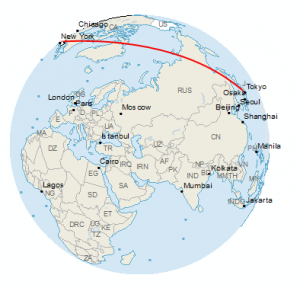How to Read a Map Latitude and Longitude

Latitude, Longitude and Coordinate Arrangement Grids
Here's how you can remember latitude and longitude:
Breadth lines run east-w and are parallel to each other. If you go due north, latitude values increase. Finally, breadth values (Y-values) range between -ninety and +90 degrees.
But longitude lines run n-south. They converge at the poles. And its 10-coordinates are betwixt -180 and +180 degrees.
Latitude and longitude coordinates make up our geographic coordinate organisation.
Map Coordinate Systems
You lot can give any location on World breadth and longitude coordinates.
The field of study that measures the shape and size of the World is geodesy. Geodesists utilize coordinate reference systems such every bit WGS84, NAD27 and NAD83. In each coordinate system, geodists utilise mathematics to give each position on World a unique coordinate.
A geographic coordinate arrangement defines two-dimensional coordinates based on the World'south surface. It has an angular unit of measure, prime summit and datum (which contains the spheroid).
Every bit shown in the image below, lines of longitude have Ten-coordinates between -180 and +180 degrees.

And on the other mitt, lines of latitudes have Y-values that are between -90 and +90 degrees.

The equator is where we measure north and south. For example, everything north of the equator has positive breadth values. Whereas, everything south of the equator has negative breadth values.
The Greenwich Meridian (or prime meridian) is a zero line of longitude from which we measure east and west. In fact, the zero line passes through the Imperial Observatory in Greenwich, England, which is why we call it what it is today. In a geographical coordinate organization, the prime height is the line that has 0° longitude.
Well-nigh horizontal datums assign the equator as a zero line of latitude. The equator is where we mensurate north and south. Whereas, the Greenwich Meridian (or prime top) is a zilch line of longitude from which we measure east and west.

Together, these lines provide a reference for latitude and longitude that always zig-zag into each other. This geographic grid gives unique breadth and longitude for every position on Earth.
Find Anything on Earth with Coordinates
Coordinates are pairs (Ten, Y) in a two-dimensional space referenced to a horizontal datum. Whereas triplets (X, Y, Z) of points not only has a position but also has top referenced to a vertical datum. In other words, the X- and Y-values stand for a horizontal position. Whereas, the Z-value represents the vertical position.

Geographic coordinate systems use an ellipsoid to gauge all locations on the surface of the world. Whereas, the datum defines the surface.
A horizontal datum has a major axis, which is the longest diameter of an ellipse. Also, information technology has a minor centrality, which is the shortest diameter of an ellipse. Finally, a horizontal datum has a radius that represents the position of the surface relative to the middle of the earth.
Additionally, time zones roughly utilize lines of longitude at xv° intervals. Starting at the Prime Meridian, at that place are 24 unlike fourth dimension zones in the world, as shown in the world fourth dimension zone map.
What is a Coordinate Reference System?
A reference ellipsoid is the mathematical model of the shape of the Earth with the major axis along the equatorial radius. A geographic coordinate system uses longitude and latitude expressed in decimal degrees. For example, WGS 1984 and NAD 1983 are the most common datums today. Before 1983, NAD27 was the most common datum.

Cartographers write spherical coordinates (latitudes and longitudes) in degrees-minutes-seconds (DMS) and decimal degrees. For degrees-minutes-seconds, minutes range from 0 to 60. For case, the geographic coordinate expressed in degrees-minutes-seconds for New York Urban center is:
- Latitude: xl degrees, 42 minutes, 51 seconds North
- Longitude: 74 degrees, 0 minutes, 21 seconds Westward
You tin can as well express geographic coordinates in decimal degrees. It's just some other manner to stand for that same location in a dissimilar format. For example, hither is New York City in decimal degrees:
- Latitude: 40.714
- Longitude: -74.006
The Federal Communications Committee has a DMS-Decimal converter tool that converts latitude and longitude between decimal degrees and degrees, minutes, and seconds.
Latitude, Longitude and Spherical Coordinate Organisation Grids
When you put ii coordinates together as a pair (10, Y), you can locate annihilation on Earth.
Latitude and longitude course our coordinate system grid.
Besides, y'all can express coordinates in different ways. For example, you can use decimal degrees or degrees-minutes-seconds.
Thanks to our geographic coordinate, you can pinpoint any point on Globe such as GPS receivers. And this includes the spot you lot are reading this article correct now.
Subscribe to our newsletter:
Source: https://gisgeography.com/latitude-longitude-coordinates/
0 Response to "How to Read a Map Latitude and Longitude"
Post a Comment